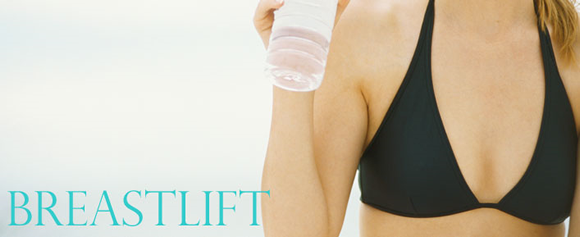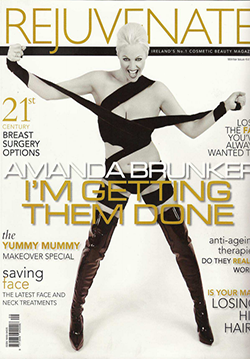Breast Lift
Often after childbirth, or just with increasing age, the breasts develop a drooping appearance. Breasts can decrease in size as a result of breast feeding and this condition is known as "postpartum involution".
If the size of the breasts is adequate, a lift is frequently necessary to restore the shape of the breast. There are three types of lifts:
- Wise Pattern - Operation in the shape of an anchor, around the areola, down and across the chest below the breast.
- LeJeour - Operation around the areola and down.
- Peri-Areolar - Operation only around the areola.
Often the operation of the breast lift is combined with a breast implant.
GENERAL INFORMATION
Mastopexy refers to lifting and reshaping the breast without necessarily reducing or increasing the breast size. The operation involves a rearrangement of the breast tissue, shifting the nipple position and increasing the breast firmness by tightening the skin. Mastopexy alone does not increase the size of the breasts. When an increase in size is desired, the procedure may be combined with the insertion of breast implants. However, the breast often appears larger when it is positioned in one place, rather than being distributed over the chest wall.
Photographs are as important to the plastic surgeon in the proper care of his patients as X-rays are to physicians in other medical specialties. Therefore, photographs are taken before and after surgery and become a permanent part of the patient's confidential medical record.
On the day surgery is performed, you will return home (or to an aftercare facility) approximately two hours after surgery.
THE ANAESTHESIA
Breast lift surgery is performed under a "light" general anesthetic (patient is asleep). This technique provides excellent operating conditions while affording maximal patient comfort and safety. The anesthetic is administered by a board-certified doctor anesthesiologist who remains in attendance throughout the operation. All of the required monitoring, anesthetic delivery and emergency equipment are present at all times. Further information, including any questions you may have, will be explained and discussed fully by your anesthesiologist prior to your surgery.
PRE-OPERATIVE PREPARATIONS
You must be in good health to undergo any elective cosmetic surgery. A physical examination and routine lab work will need to be performed by your own primary physician. If you do not have a primary doctor, we can refer you to local doctors in our area. We do not provide these services. It will be required that all this pre-op paperwork is in our office 1-2 weeks prior to surgery.
It is required that someone drive you home upon your discharge and you should also arrange for transportation to and from our office for your post-operative appointments until your doctor gives you permission to drive.
DO NOT take aspirin or aspirin-containing products for 2 weeks prior to surgery and for 2 weeks after surgery.
An adequate diet with vitamin supplements, especially Vitamin C, is recommended. You should be in the best nutritional state possible prior to surgery.
If you will be preparing your own meals at home after surgery, have on hand easy to prepare foods.
Bring loose-fitting, front-opening clothing with you the morning of surgery to wear home.
THE SURGICAL PROCEDURE
Marking and measuring is an important part of the preparation for surgery. The markings are made before the patient is heavily sedated with the patient sitting in a fully upright position. These markings are used for guidelines for the incisions during surgery when the patient is in a reclining position. The surgical procedure consists of removing part of the breast skin, moving the nipple upward and reshaping the remaining tissue into a higher, firmer configuration. If implants are to be used, they are inserted at this time. The incisions are closed with fine suture material and tapes. The scars left by this surgery fade with time, but they are permanent. There is a circular scar around the nipple, a scar in the fold under the breasts and a vertical scar connecting them. No scars are present above the nipple. Newer advances allow the scars to be much smaller than in the past.
POSSIBLE COMPLICATIONS
Complications are infrequent and usually respond promptly to proper treatment without unfavourably affecting the final surgical result
Bleeding - if bleeding occurs after the operation, it may accumulate in the breast and require opening the wound to remove the blood and prevent further bleeding.
Infection - this occurs rarely and usually responds to antibiotics.
Numbness of the nipple- this is almost always temporary and sensation can be expected to return in most cases. On rare occasions, however, it may be permanent.
Loss of a nipple - complete or partial loss of a nipple is extremely rare, but has been reported in medical literature. Should this happen, a reconstructive operation can be performed with satisfactory results at a later date.
Occasionally, a revision of the scars is necessary in order to obtain optimum aesthetic results. These revision procedures are minor and can be carried out in the office under local anaesthesia.
WHAT TO EXPECT AFTER SURGERY
PAIN - Pain is rarely severe, more commonly being a degree of discomfort. Pain medication is prescribed by the doctor for the patient to use at home.
SWELLING - This does occur but usually begins to subside by the third or fourth day. Some degree of swelling may persist for weeks, or even months.
SURGICAL BRA - this is applied at the time of surgery and is left in place for two weeks after the operation. Steri-strips covering all incisions are removed and replaced by the nurse in 5-6 days. After two weeks, a comfortable sports bra can be purchased. Avoid purchasing underwire bras that would create too much pressure on incisions.
Social and work activities should be quite limited for two to three weeks after surgery. If your job requires lifting, pushing, etc., a longer recuperation period may be necessary. Driving should be avoided for one week after surgery.
POST-OPERATIVE CARE
Rest as much as possible for the first week, and then gradually increase your activities over the next few weeks.
Avoid raising your arms over your head for 2 weeks. Avoid any strenuous exercising or lifting for 6 weeks.
Avoid lying on your abdomen for 2 weeks. Optimal sleep position is elevated on your back with 2 pillows. Keep a pillow under each arm, and a pillow under your knees.
Showering is usually permitted after 72 hours. Do not attempt to peel off the steri-strips; the nurse will change them. Soaking in the bathtub is not recommended for two to three weeks.
After 2-3 weeks, or when all scabs have fallen off, begin using Scarease gel (apply lightly every night), and Vitamin C & E serum (apply lightly every morning) directly to incisions for several weeks. These products can be purchased in our office, and can be mailed to out of town patients.
RESUMPTION OF PHYSICAL ACTIVITIES-GENERAL RULE OF THUMB TWO, FOUR, SIX RULE FIRST WEEK- TAKE IT EASY!!! PATIENTS WHO ARE TOO VIGOROUS FREQUENTLY DEVELOP COMPLICATIONS!
At two weeks - take long walks on a flat surface. No other kind of workouts. Any activity that would raise your blood pressure would compromise the healing incisions and newly developing blood supply.
At four weeks - light exercise such as aerobics, but no weight training. Start light. For example, if you normally do 30 minutes on a treadmill, begin with 15 minutes, then increase as your body gets used to things. Use of vitamin C and E concentrate and scar-fade gel should begin as soon as the incisions are completely healed, usually 3-4 weeks.
At six weeks - resume all previous activities with clearance from Dr Kremer. Avoid sun exposure to incision site for months following surgery, as this may result in a hyper-pigmented scar.
Please check for further information on the breast lift in plastic surgery by Dr Dirk Kremer.
Book a Consultation
Dr Kremer conducts virtual consultations via WhatsApp or Zoom and in-person consultations at our office in Harley Street, London. If you would like to book a consultation, or would like more information, simply get in touch with us via phone, email or through our contact form and we will schedule a date and time for your consultation.






